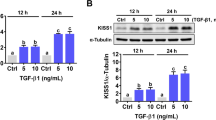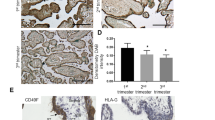Abstract
The invasion of extravillous trophoblasts into the uterine wall is of crucial importance for placental and fetal development, and its dysregulation has been implicated in a wide spectrum of abnormal pregnancies. Mechanistically, trophoblast invasion strongly resembles the invasion of tumour cells, but differs from it by tight regulation in time and space. This regulation is accomplished by different factors including cytokines and hormones, which are produced by both fetal as well as maternal tissues i.e., placenta and uterus, respectively. Recently, products of the KiSS-1 gene (kisspeptins) have been identified to not only inhibit metastasis in various tumours, but also to repress trophoblast invasion via binding to the G protein-coupled receptor KiSS-1R. In the placenta, expression levels of kisspeptins and their receptor are highest in the first trimester in humans and at day 12.5 in rats, respectively. This coincides with the time when invasiveness peaks and invasion regulation is of central importance. Human kisspeptins are predominantly produced by the syncytiotrophoblast, whereas KiSS-1R is additionally expressed on the invading extravillous trophoblasts indicating a paracrine regulation of extravillous trophoblast invasion by the syncytiotrophoblast. In the structurally different rat placenta both KiSS-1 and its receptor are predominantly expressed by the invasive trophoblast giant cells, thus establishing an autocrine system in the invasion regulation of this trophoblast subpopulation. Amongst all kisspeptins the highly conserved kisspeptin Kp-10 has strongest invasion inhibiting effects suggesting its major role in regulation of trophoblast invasion.







Similar content being viewed by others
References
Murray MJ, Lessey BA. Embryo implantation and tumor metastasis: common pathways of invasion and angiogenesis. Semin Reprod Endocrinol 1999;17(3):275.
Strickland S, Richards WG. Invasion of the trophoblasts. Cell 1992;71(3):355.
Soundararajan R, Rao AJ. Trophoblast ‘pseudo-tumorigenesis’: significance and contributory factors. Reprod Biol Endocrinol 2004;2:15.
Pijnenborg R, Dixon G, Robertson WB, Brosens I. Trophoblastic invasion of human decidua from 8 to 18 weeks of pregnancy. Placenta 1980;1(1):3.
Shih IM, Kurman RJ. New concepts in trophoblastic growth and differentiation with practical application for the diagnosis of gestational trophoblastic disease. Verh Dtsch Ges Pathol 1997;81:266.
Norwitz ER, Schust DJ, Fisher SJ. Implantation and the survival of early pregnancy. N Engl J Med 2001;345(19):1400.
Goldman-Wohl D, Yagel S. Regulation of trophoblast invasion: from normal implantation to pre-eclampsia. Mol Cell Endocrinol 2002;187(1–2):233.
Kaufmann P, Black S, Huppertz B. Endovascular trophoblast invasion: implications for the pathogenesis of intrauterine growth retardation and preeclampsia. Biol Reprod 2003;69(1):1.
Graham CH, Lala PK. Mechanism of control of trophoblast invasion in situ. J Cell Physiol 1991;148(2):228.
Irving JA, Lala PK. Functional role of cell surface integrins on human trophoblast cell migration: regulation by TGF-beta, IGF-II, and IGFBP-1. Exp Cell Res 1995;217(2):419.
Genbacev O, Miller RK. Post-implantation differentiation and proliferation of cytotrophoblast cells: in vitro models—a review. Placenta 2000;21(Suppl A):S45.
Rama S, Petrusz P, Rao AJ. Hormonal regulation of human trophoblast differentiation: a possible role for 17beta-estradiol and GnRH. Mol Cell Endocrinol 2004;218(1–2):79.
Renaud SJ, Postovit LM, Macdonald-Goodfellow SK, McDonald GT, Caldwell JD, Graham CH. Activated macrophages inhibit human cytotrophoblast invasiveness in vitro. Biol Reprod 2005;73(2):237.
Benyo DF, Miles TM, Conrad KP. Hypoxia stimulates cytokine production by villous explants from the human placenta. J Clin Endocrinol Metab 1997;82(5):1582.
Bauer S, Pollheimer J, Hartmann J, Husslein P, Aplin JD, Knofler M. Tumor necrosis factor-alpha inhibits trophoblast migration through elevation of plasminogen activator inhibitor-1 in first-trimester villous explant cultures. J Clin Endocrinol Metab 2004;89(2):812.
Bilban M, Ghaffari-Tabrizi N, Hintermann E, Bauer S, Molzer S, Zoratti C, et al. Kisspeptin-10, a KiSS-1/metastin-derived decapeptide, is a physiological invasion inhibitor of primary human trophoblasts. J Cell Sci 2004;117(Pt 8):1319.
Lee JH, Miele ME, Hicks DJ, Phillips KK, Trent JM, Weissman BE, et al. KiSS-1, a novel human malignant melanoma metastasis-suppressor gene. J Natl Cancer Inst 1996;88(23):1731.
Ohtaki T, Shintani Y, Honda S, Matsumoto H, Hori A, Kanehashi K, et al. Metastasis suppressor gene KiSS-1 encodes peptide ligand of a G-protein-coupled receptor. Nature 2001;411(6837):613.
Kotani M, Detheux M, Vandenbogaerde A, Communi D, Vanderwinden JM, Le Poul E, et al. The metastasis suppressor gene KiSS-1 encodes kisspeptins, the natural ligands of the orphan G protein-coupled receptor GPR54. J Biol Chem 2001;276(37):34631.
Stafford LJ, Xia C, Ma W, Cai Y, Liu M. Identification and characterization of mouse metastasis-suppressor KiSS1 and its G-protein-coupled receptor. Cancer Res 2002;62(19):5399.
Harms JF, Welch DR, Miele ME. KISS1 metastasis suppression and emergent pathways. Clin Exp Metastasis 2003;20(1):11.
Tomita K, Niida A, Oishi S, Ohno H, Cluzeau J, Navenot JM, et al. Structure-activity relationship study on small peptidic GPR54 agonists. Bioorg Med Chem 2006;14(22):7595.
Ringel MD, Hardy E, Bernet VJ, Burch HB, Schuppert F, Burman KD, et al. Metastin receptor is overexpressed in papillary thyroid cancer and activates MAP kinase in thyroid cancer cells. J Clin Endocrinol Metab 2002;87(5):2399.
Yan C, Wang H, Boyd DD. KiSS-1 represses 92-kDa type IV collagenase expression by down-regulating NF-kappa B binding to the promoter as a consequence of Ikappa Balpha-induced block of p65/p50 nuclear translocation. J Biol Chem 2001;276(2):1164.
Lee JH, Welch DR. Suppression of metastasis in human breast carcinoma MDA-MB-435 cells after transfection with the metastasis suppressor gene, KiSS-1. Cancer Res 1997;57(12):2384.
Masui T, Doi R, Mori T, Toyoda E, Koizumi M, Kami K, et al. Metastin and its variant forms suppress migration of pancreatic cancer cells. Biochem Biophys Res Commun 2004;315(1):85.
Ikeguchi M, Yamaguchi K, Kaibara N. Clinical significance of the loss of KiSS-1 and orphan G-protein-coupled receptor (hOT7T175) gene expression in esophageal squamous cell carcinoma. Clin Cancer Res 2004;10(4):1379.
Sanchez-Carbayo M, Capodieci P, Cordon-Cardo C. Tumor suppressor role of KiSS-1 in bladder cancer: loss of KiSS-1 expression is associated with bladder cancer progression and clinical outcome. Am J Pathol 2003;162(2):609.
Navenot JM, Wang Z, Chopin M, Fujii N, Peiper SC. Kisspeptin-10-induced signaling of GPR54 negatively regulates chemotactic responses mediated by CXCR4: a potential mechanism for the metastasis suppressor activity of kisspeptins. Cancer Res 2005;65(22):10450.
Becker JA, Mirjolet JF, Bernard J, Burgeon E, Simons MJ, Vassart G, et al. Activation of GPR54 promotes cell cycle arrest and apoptosis of human tumor cells through a specific transcriptional program not shared by other Gq-coupled receptors. Biochem Biophys Res Commun 2005;326(3):677.
Muir AI, Chamberlain L, Elshourbagy NA, Michalovich D, Moore DJ, Calamari A, et al. AXOR12, a novel human G protein-coupled receptor, activated by the peptide KiSS-1. J Biol Chem 2001;276(31):28969.
Horikoshi Y, Matsumoto H, Takatsu Y, Ohtaki T, Kitada C, Usuki S, et al. Dramatic elevation of plasma metastin concentrations in human pregnancy: metastin as a novel placenta-derived hormone in humans. J Clin Endocrinol Metab 2003;88(2):914.
Janneau JL, Maldonado-Estrada J, Tachdjian G, Miran I, Motte N, Saulnier P, et al. Transcriptional expression of genes involved in cell invasion and migration by normal and tumoral trophoblast cells. J Clin Endocrinol Metab 2002;87(11):5336.
Benirschke K, Kaufmann P, Baergen R. Pathology of the human placenta. New York: Springer; 2006.
Dhar DK, Naora H, Kubota H, Maruyama R, Yoshimura H, Tonomoto Y, et al. Downregulation of KiSS-1 expression is responsible for tumor invasion and worse prognosis in gastric carcinoma. Int J Cancer 2004;111(6):868.
Bischof P, Meisser A, Campana A. Paracrine and autocrine regulators of trophoblast invasion—a review. Placenta 2000;21(Suppl A):S55.
Terao Y, Kumano S, Takatsu Y, Hattori M, Nishimura A, Ohtaki T, et al. Expression of KiSS-1, a metastasis suppressor gene, in trophoblast giant cells of the rat placenta. Biochim Biophys Acta 2004;1678(2–3):102.
Cross JC. Genetic insights into trophoblast differentiation and placental morphogenesis. Semin Cell Dev Biol 2000;11(2):105.
Roa J, Vigo E, Castellano JM, Navarro VM, Fernandez-Fernandez R, Casanueva FF, et al. Hypothalamic expression of KiSS-1 system and gonadotropin-releasing effects of kisspeptin in different reproductive states of the female Rat. Endocrinology 2006;147(6):2864.
Qiao C, Wang CH, Shang T, Lin QD. [Clinical significance of KiSS-1 and matrix metalloproteinase-9 expression in trophoblasts of women with preeclampsia and their relation to perinatal outcome of neonates]. Zhonghua Fu Chan Ke Za Zhi 2005;40(9):585.
Seminara SB, Kaiser UB. New gatekeepers of reproduction: GPR54 and its cognate ligand, KiSS-1. Endocrinology 2005;146(4):1686.
Lechan RM, Fekete C. Feedback regulation of thyrotropin-releasing hormone (TRH): mechanisms for the non-thyroidal illness syndrome. J Endocrinol Investig 2004;27(6 Suppl):105.
Takino T, Koshikawa N, Miyamori H, Tanaka M, Sasaki T, Okada Y, et al. Cleavage of metastasis suppressor gene product KiSS-1 protein/metastin by matrix metalloproteinases. Oncogene 2003;22(30):4617.
Bischof P, Campana A. Molecular mediators of implantation. Baillieres Best Pract Res Clin Obstet Gynaecol 2000;14(5):801.
Acknowledgments
This work was supported by grants 7535, 7793, 10053, 10896 and 11964, Jubilee Fund, Austrian National Bank, Vienna to Gernot Desoye and by grant P17894-B14, Austrian Science Fund, Vienna, to Martin Knöfler.
Author information
Authors and Affiliations
Corresponding author
Rights and permissions
About this article
Cite this article
Hiden, U., Bilban, M., Knöfler, M. et al. Kisspeptins and the placenta: Regulation of trophoblast invasion. Rev Endocr Metab Disord 8, 31–39 (2007). https://doi.org/10.1007/s11154-007-9030-8
Published:
Issue Date:
DOI: https://doi.org/10.1007/s11154-007-9030-8




